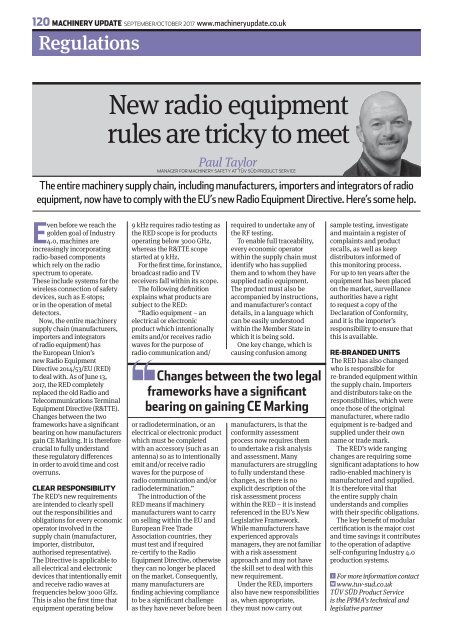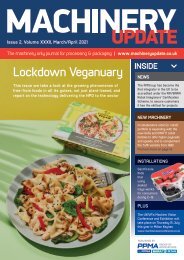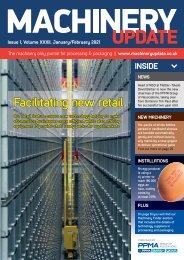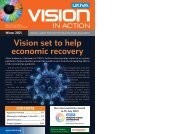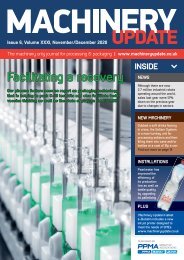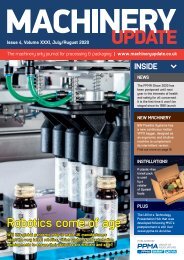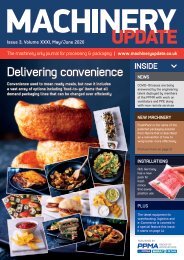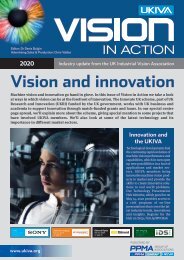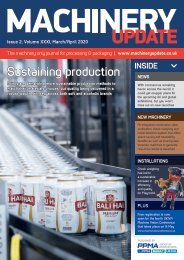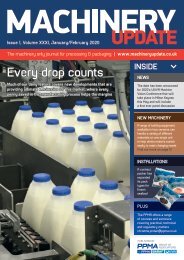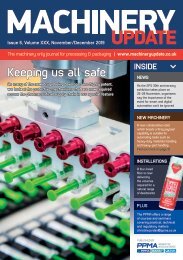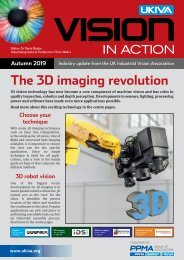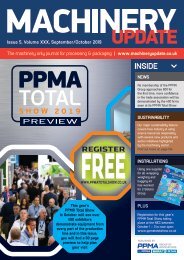Machinery Update September \ October 2017
Machinery Update September \ October 2017 - PPMA Show Preview
Machinery Update September \ October 2017 - PPMA Show Preview
Create successful ePaper yourself
Turn your PDF publications into a flip-book with our unique Google optimized e-Paper software.
120 MACHINERY UPDATE SEPTEMBER/OCTOBER <strong>2017</strong> www.machineryupdate.co.uk<br />
Regulations<br />
New radio equipment<br />
rules are tricky to meet<br />
Paul Laidler Taylor<br />
BuSinESS ManaGER diRECTOR fOR MaChinERy fOR MaChinERy SafETy SafTEy aT Tüv aT Süd Tüv PROduCT Süd PROduCT SERviCE SERviCE<br />
The entire machinery supply chain, including manufacturers, importers and integrators of radio<br />
equipment, now have to comply with the EU’s new Radio Equipment Directive. Here’s some help.<br />
Even before we reach the<br />
golden goal of Industry<br />
4.0, machines are<br />
increasingly incorporating<br />
radio-based components<br />
which rely on the radio<br />
spectrum to operate.<br />
These include systems for the<br />
wireless connection of safety<br />
devices, such as E-stops;<br />
or in the operation of metal<br />
detectors.<br />
Now, the entire machinery<br />
supply chain (manufacturers,<br />
importers and integrators<br />
of radio equipment) has<br />
the European Union’s<br />
new Radio Equipment<br />
Directive 2014/53/EU (RED)<br />
to deal with. As of June 13,<br />
<strong>2017</strong>, the RED completely<br />
replaced the old Radio and<br />
Telecommunications Terminal<br />
Equipment Directive (R&TTE).<br />
Changes between the two<br />
frameworks have a significant<br />
bearing on how manufacturers<br />
gain CE Marking. It is therefore<br />
crucial to fully understand<br />
these regulatory differences<br />
in order to avoid time and cost<br />
overruns.<br />
CLEAR RESPONSIBILITY<br />
The RED’s new requirements<br />
are intended to clearly spell<br />
out the responsibilities and<br />
obligations for every economic<br />
operator involved in the<br />
supply chain (manufacturer,<br />
importer, distributor,<br />
authorised representative).<br />
The Directive is applicable to<br />
all electrical and electronic<br />
devices that intentionally emit<br />
and receive radio waves at<br />
frequencies below 3000 GHz.<br />
This is also the first time that<br />
equipment operating below<br />
9 kHz requires radio testing as<br />
the RED scope is for products<br />
operating below 3000 GHz,<br />
whereas the R&TTE scope<br />
started at 9 kHz.<br />
For the first time, for instance,<br />
broadcast radio and TV<br />
receivers fall within its scope.<br />
The following definition<br />
explains what products are<br />
subject to the RED:<br />
“Radio equipment – an<br />
electrical or electronic<br />
product which intentionally<br />
emits and/or receives radio<br />
waves for the purpose of<br />
radio communication and/<br />
or radiodetermination, or an<br />
electrical or electronic product<br />
which must be completed<br />
with an accessory (such as an<br />
antenna) so as to intentionally<br />
emit and/or receive radio<br />
waves for the purpose of<br />
radio communication and/or<br />
radiodetermination.”<br />
The introduction of the<br />
RED means if machinery<br />
manufacturers want to carry<br />
on selling within the EU and<br />
European Free Trade<br />
Association countries, they<br />
must test and if required<br />
re-certify to the Radio<br />
Equipment Directive, otherwise<br />
they can no longer be placed<br />
on the market. Consequently,<br />
many manufacturers are<br />
finding achieving compliance<br />
to be a significant challenge<br />
as they have never before been<br />
required to undertake any of<br />
the RF testing.<br />
To enable full traceability,<br />
every economic operator<br />
within the supply chain must<br />
identify who has supplied<br />
them and to whom they have<br />
supplied radio equipment.<br />
The product must also be<br />
accompanied by instructions,<br />
and manufacturer’s contact<br />
details, in a language which<br />
can be easily understood<br />
within the Member State in<br />
which it is being sold.<br />
One key change, which is<br />
causing confusion among<br />
Changes between the two legal<br />
frameworks have a significant<br />
bearing on gaining CE Marking<br />
manufacturers, is that the<br />
conformity assessment<br />
process now requires them<br />
to undertake a risk analysis<br />
and assessment. Many<br />
manufacturers are struggling<br />
to fully understand these<br />
changes, as there is no<br />
explicit description of the<br />
risk assessment process<br />
within the RED – it is instead<br />
referenced in the EU’s New<br />
Legislative Framework.<br />
While manufacturers have<br />
experienced approvals<br />
managers, they are not familiar<br />
with a risk assessment<br />
approach and may not have<br />
the skill set to deal with this<br />
new requirement.<br />
Under the RED, importers<br />
also have new responsibilities<br />
as, when appropriate,<br />
they must now carry out<br />
sample testing, investigate<br />
and maintain a register of<br />
complaints and product<br />
recalls, as well as keep<br />
distributors informed of<br />
this monitoring process.<br />
For up to ten years after the<br />
equipment has been placed<br />
on the market, surveillance<br />
authorities have a right<br />
to request a copy of the<br />
Declaration of Conformity,<br />
and it is the importer’s<br />
responsibility to ensure that<br />
this is available.<br />
RE-BRANDED UNITS<br />
The RED has also changed<br />
who is responsible for<br />
re-branded equipment within<br />
the supply chain. Importers<br />
and distributors take on the<br />
responsibilities, which were<br />
once those of the original<br />
manufacturer, where radio<br />
equipment is re-badged and<br />
supplied under their own<br />
name or trade mark.<br />
The RED’s wide ranging<br />
changes are requiring some<br />
significant adaptations to how<br />
radio-enabled machinery is<br />
manufactured and supplied.<br />
It is therefore vital that<br />
the entire supply chain<br />
understands and complies<br />
with their specific obligations.<br />
The key benefit of modular<br />
certification is the major cost<br />
and time savings it contributes<br />
to the operation of adaptive<br />
self-configuring Industry 4.0<br />
production systems.<br />
i For more information contact<br />
W www.tuv-sud.co.uk<br />
TÜV SÜD Product Service<br />
is the PPMA’s technical and<br />
legislative partner


